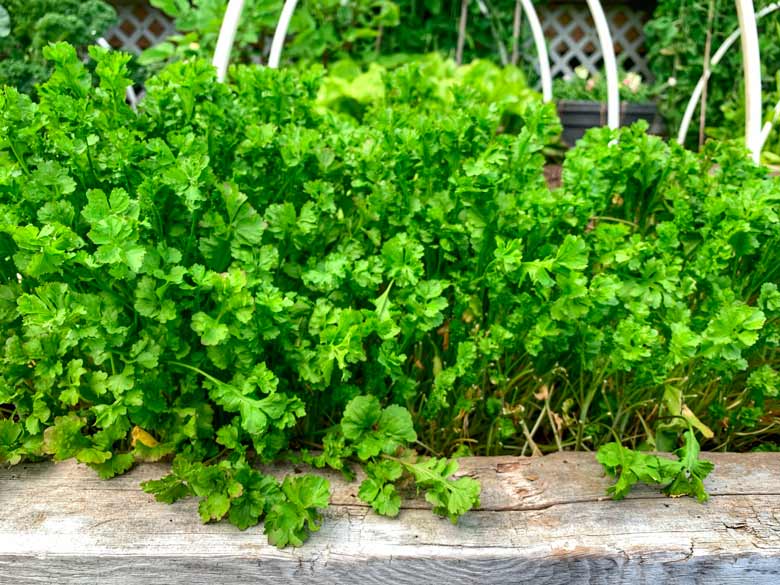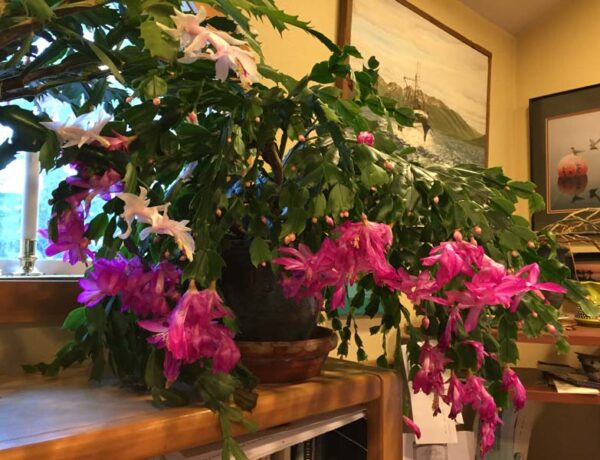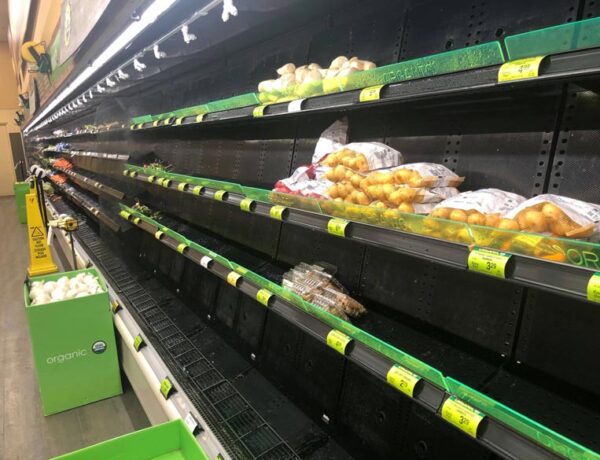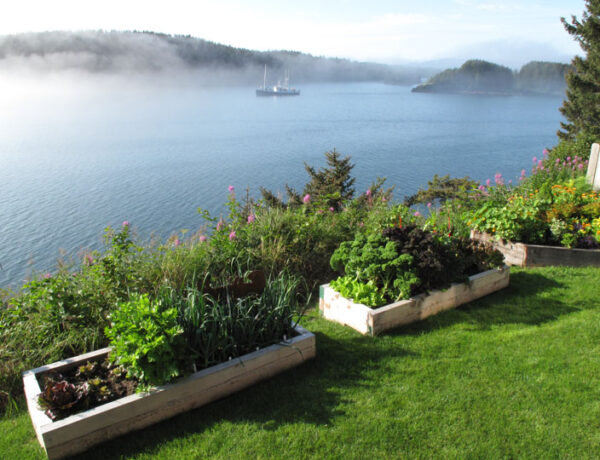What’s a summer garden without hiccups? Weeds double in height when your back is turned and since the baby crows have fledged, their parents dive-bomb any creature that moves, including gardeners. Also on the bitch-list: Armies of baby slugs invaded the hoophouse and my cucumber seedlings simply stopped growing…
“It’s too cold,” they insist. “We’re waiting for warmer weather.”
When I visited the Strawberry Fields nursery last week, it was to find cucumber seedlings to replace the ones that are on strike.
“They’ve hardly grown a foot since spring,” I groaned to Judy, who was on duty that day.
“Well, if it will make you feel any better,” she replied with a wink, “you’re about the fortieth person to say that in the past few days.”
Feed ’em candy
As for baby slugs, you might relate to the problem: They’re too small for bait such as Sluggo. So I turned to another trick: feed them candy.
Not a Hershey bar, but something extra tender and sweet to a slug: Bok choy.
I allow them to eat on it to their heart’s (do slugs have hearts?) content. The Bok Choy becomes a sacrificial plant and eventually, it succumbs to holes and slime. It’s a mess, but it works.
I found another mess the other day: After donning my garden sweatshirt, I reached into the pouch. Kleenex, a sticky cough drop, and a handful of loose seeds.
They must have spilled out of a long-lost seed packet. Smaller than rice and, I recognized the tan seeds as one of my favorite greens: Wrinkled Crinkled Crumpled Cress.
Yup, it’s a tongue-twister, but this cress is worth every bit of effort:
- It’s hardy…
- Easy to grow
- Resists bolting
- Terrifically multi-purpose
- You can use it fresh or cooked
Another green, as healthy or better than cress, is chickweed. I featured this spindly, fast-growing seed in a column last month.
The food world has rediscovered cress. My grandmother served butter and cress sandwiches; minus the crusts, of course. Since those days, cress’ popularity sank to the status of garnish, as did parsley.
[Dear reader, This article you’re reading was originally published in the Kodiak Daily Mirror, the hometown newspaper for Kodiak, Alaska. Go here to access the archive page for past columns, written each week since 1986].
Cress: The New Superfood!
Cress is now considered a superfood, topping the list of 41 “powerhouse fruits and vegetables.” In a study published in the Centers for Disease Control and Prevention’s journal, “Preventing Chronic Disease,”
…the superfoods are scored by the amounts of 17 critical nutrients they contain, such as fiber, potassium, protein, calcium, folate, vitamin B12, vitamin A, vitamin D, and other nutrients–all important to our health.
You might know cress as watercress. Yes, it grows wild along streambanks and is often ignored by walkers, drivers, and bicyclists. It might not be ignored if they realized that cress packs large amounts of a wide variety of these important substances described above.
In fact, cress topped the chart with a score of 100.
The next five in the “best of” category included:
- Chinese cabbage
- chard
- beet greens
- spinach
- chicory
While we can’t grow chicory in Kodiak, we can grow the remaining four list-toppers. And in case you’re wondering, leaf lettuce, parsley, romaine lettuce, collard greens, turnip greens, mustard greens, endive, chive, and kale (which happily grow in Kodiak) follow close behind.
I find it amusing, in a sad sort of way, that watercress tops the nutritional charts because it’s mostly sidelined as a weed. At least in the U.S. Across the Atlantic, watercress holds a kingly status, recognized for its value to a healthy diet and grown in large-scale commercial operations.
Cress is one of the few plants that thrive hydroponically.
Ever been to a cress-tival?
In the United Kingdom, a watercress festival brings 15,000 visitors annually. Back in the 1940s, Huntsville, Alabama was once known locally as the watercress capital of the world. Today, Oviedo, Florida carries the title. Know anyone that lives there? Please let me know.
Along with basic nutrition, cress has many health benefits. Because it is relatively rich in Vitamin C, watercress was suggested (among other plants) by English military surgeon John Woodall around 1600 as a remedy for scurvy. Many benefits from eating cress include anti-cancer properties, especially lung cancer.
While there are many kinds of cress, I prefer Wrinkled Crinkled Crumpled Cress. I love its upright growth habit (easy for cutting) and its unique curly leaves that give a bounce and not-too-peppery flavor to salads, sandwiches, pesto, and wraps.
As I said, cress is easy to grow in containers or raised beds; hoophouse or outside. You can sow it directly in the soil or start a batch indoors. Germination happens in a matter of days. In fact, the seedlings are so fast-growing, you can sprout them like radish and alfalfa seeds, and get multiple crops.
Even when it starts to bolt (send up tiny, white flowers), I use the whole plant for making pesto. That would be cress-to, right? Simply replace some of the basil, spinach, whatever with cress.
You’ll love this little ditty from Fedco Seeds (fedcoseeds.com):
Salad green that will impress.
Mix some lettuce, add some dress.
Stir it up, sit down and fress.
Banish cares and summer stress.
Cress, Pear and Feta Salad
You can change up this recipe a bazillion ways…
4 cups chopped cress
1 pear, cut into small bits
1/2 banana, diced (optional)
Lime juice or seasoned rice vinegar
1/2 cup feta cheese
Toss the first three ingredients into a bowl. Serve topped with feta cheese. Sprinkle with almonds or sesame seeds.
While cucumber seedlings have been flying out the door at Strawberry Fields, cress has been flying around inside my Cuisinart on its way to pesto…
By the way, now is a good time to sow a few lines of cress. It will be ready to eat just about the time the silver salmon are running.
Thanks for being here. Give the recipe a try and let me know in the comments what you think. Thanks!
Blessings to you and your family,

The garden Job Jar:
+ Share your harvest with friends and neighbors.
+ When pulling up broccoli, cabbage, and other brassica crops, check the roots: If the root mass is brown and twisted into a knot, your plants may have succumbed to clubroot.
+ Make compost, take pictures, pull weeds, be grateful
PS Wow, imagine what would it be like to cut your garden maintenance in half? Or help your plants survive a drought… After 35 years of gardening, I have learned one important thing: Compost is the answer to all your problems. Want to know how to make compost in just 6 weeks? Begin by taking this composting assessment. And hey, you might enjoy my Joy of Composting Facebook page. If you’d like to drop me a note, here’s my email address: marion (at) marionowenalaska.com.





No Comments